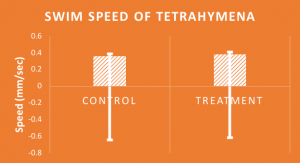Lab 13: Ciliate Isolation and Characterization
11/15/18
Purpose:
The purpose of this lab was to fid the soil texture of our soil sample using percent composition of clay, silt, and sand. Also, a purpose was to find and identify a ciliate in our sample.
Procedure:
- Retrieve the test tube of soil that were stored to separate the mixture.
- Measure each cm of clay, silt, and sand. Take the percentage to find the soil texture.
- Retrieve the non-flooded plate if a ciliate has been found. Retrieve a sample jar if none have been found.
- Micropipette 5 10uL drops onto a concavity slide. Micropipette a 10uL drop of water onto each drop to dilute it.
- Search for ciliates under a dissection microscope and micropipette any ciliates seen to isolate if any are found.
- If one is found, take a picture and video. Record any seen characteristics.
Data/Observations:
| cm | Percent composition | |
| Total | 5.4 | |
| Silt | 1.0 | 19% |
| Sand | 2.3 | 43% |
| Clay | 2.1 | 39% |
Texture= clay loam
No ciliates were found. A microscopic water bug and a small worm were viewed.
Conclusion:
The microscopes were covered and put away. The petri dishes and jars of sample soil were returned to their bins. The concavity slides were washed. Micropipette tips were thrown away. I was able to understand how to dilute soil in order to find ciliates more easily. Although no ciliates were found, I was also able to see the diversity in microscopic organisms as I was able to view other organisms, such as microscopic bugs and worms. The soil sample texture was also able to tell me much about the types of organisms that live in that particular soil environment. I think, when combined with class data, it will be telling of the diversity of soil and how their environment is dependent of soil texture.







